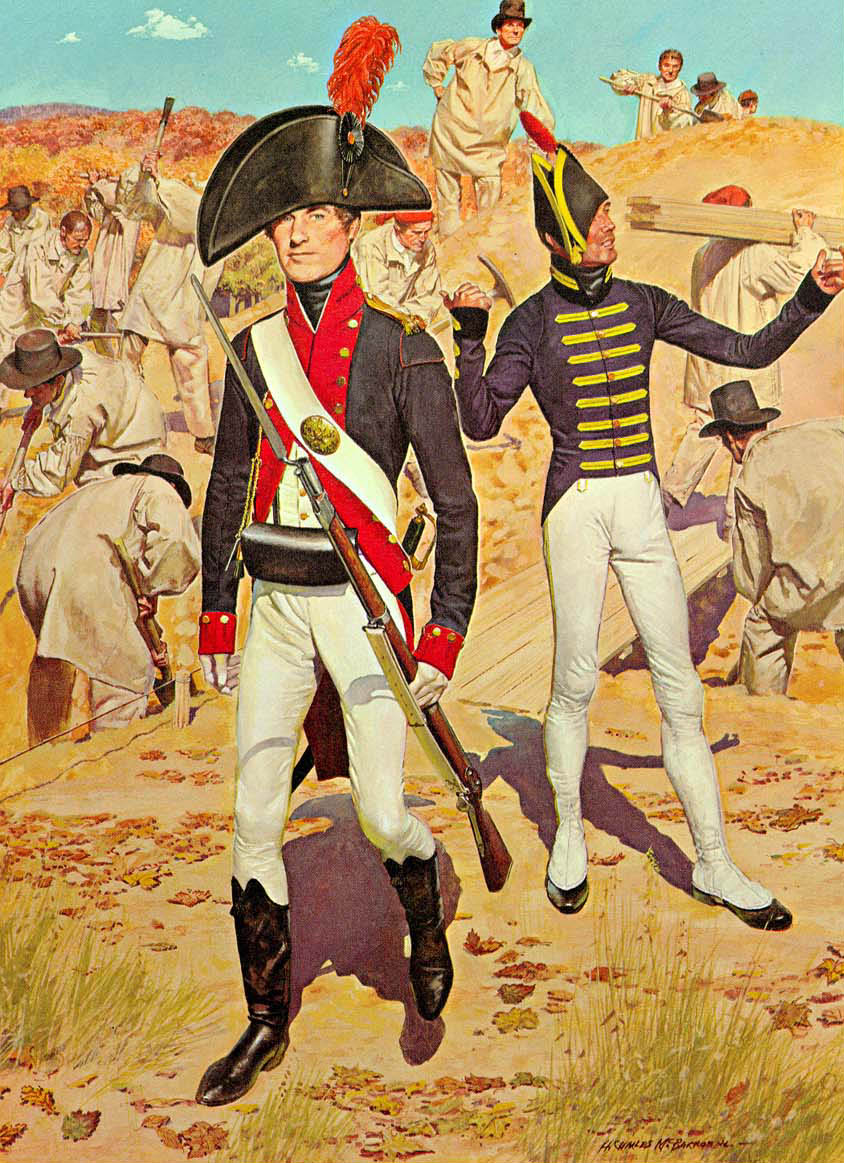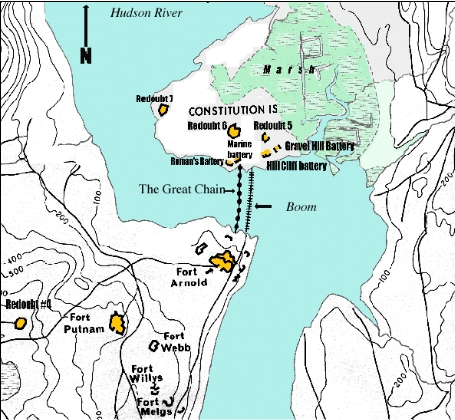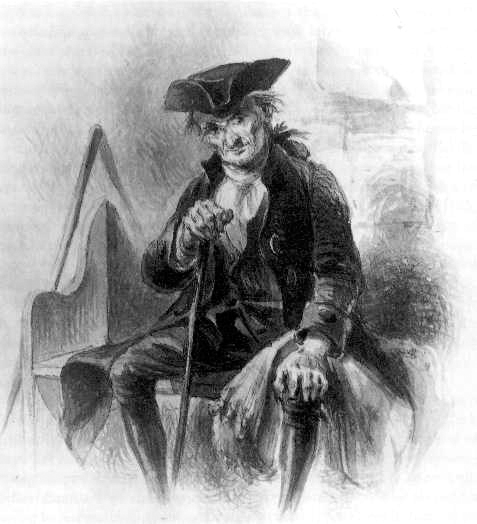|
Anthony's Nose
Anthony's Nose is a peak in the Hudson Highlands along the east bank of the Hudson River in the hamlet of Cortlandt Manor, New York. It lies at the extreme northwest end of Westchester County, and serves as the east anchor of the Bear Mountain Bridge. Topography Anthony's Nose, together with Dunderberg Mountain, comprises the South Gate of the Hudson Highlands. It forms a ridge running northeast and southwest, being separated from Canada Hill to the northeast by Copper Mine Brook and the "South Mountain Pass", and being bordered on the southwest by the Hudson. The Hudson makes a turn around the southwestern tip, so that the northwestern side also slopes down to salt marshes along the river. On the southeastern side are Mine Mountain and, across Broccy Creek, Manitou Mountain. Most of this land is part of Camp Smith, a New York National Guard reservation.New York–New Jersey Trail Conference Trail Map 101, East Hudson Trails: Hudson Highlands State Park US 6/ 202 cross ... [...More Info...] [...Related Items...] OR: [Wikipedia] [Google] [Baidu] |
Hudson River
The Hudson River, historically the North River, is a river that flows from north to south largely through eastern New York (state), New York state. It originates in the Adirondack Mountains at Henderson Lake (New York), Henderson Lake in the town of Newcomb, New York, Newcomb, and flows south to the New York Bay , New York Bay, a tidal estuary between New York City, New York and Jersey City, Jersey City, before draining into the Atlantic Ocean , Atlantic Ocean. The river marks boundaries between several County (New York), New York counties and the eastern border between the U.S. states of New York and New Jersey , New Jersey. The lower half of the river is a tidal estuary, deeper than the body of water into which it flows, occupying the Hudson Fjord, an inlet that formed during the most recent period of North American Quaternary glaciation, glaciation, estimated at 26,000 to 13,300 years ago. Even as far north as the city of Troy, New York, Troy, the flow of the river chan ... [...More Info...] [...Related Items...] OR: [Wikipedia] [Google] [Baidu] |
Hudson Line (Metro-North)
The Hudson Line is a commuter rail line owned and operated by the Metro-North Railroad in the U.S. state of New York (state), New York. It runs north from New York City along the east shore of the Hudson River, terminating at Poughkeepsie (Metro-North station), Poughkeepsie. The line was originally the Hudson River Railroad (and the Spuyten Duyvil and Port Morris Railroad south of Spuyten Duyvil, Bronx, Spuyten Duyvil), and eventually became the Hudson Division of the New York Central Railroad. It runs along what was the far southern leg of the Central's famed "Water Level Route" to Chicago. Croton–Harmon (Metro-North station), Croton–Harmon station divides the line into two distinct segments. South of there, the line is rail electrification, electrified with third rail, serving suburban stations located relatively close together. Most of the electrified zone has four tracks, usually two express and local tracks in each direction. For a few miles in the Bronx between Spuyten ... [...More Info...] [...Related Items...] OR: [Wikipedia] [Google] [Baidu] |
Radio Direction Finder
Direction finding (DF), radio direction finding (RDF), or radiogoniometry is the use of radio waves to determine the direction to a radio source. The source may be a cooperating radio transmitter or may be an inadvertent source, a naturally-occurring radio source, or an illicit or enemy system. Radio direction finding differs from radar in that only the direction is determined by any one receiver; a radar system usually also gives a distance to the object of interest, as well as direction. By triangulation, the location of a radio source can be determined by measuring its direction from two or more locations. Radio direction finding is used in radio navigation for ships and aircraft, to locate emergency transmitters for search and rescue, for tracking wildlife, and to locate illegal or interfering transmitters. During the Second World War, radio direction finding was used by both sides to locate and direct aircraft, surface ships, and submarines. RDF systems can be used ... [...More Info...] [...Related Items...] OR: [Wikipedia] [Google] [Baidu] |
West Point
The United States Military Academy (USMA), commonly known as West Point, is a United States service academies, United States service academy in West Point, New York that educates cadets for service as Officer_(armed_forces)#United_States, commissioned officers in the United States Army. The academy was founded in 1802, and it is the oldest of the five United States service academies, American service academies. The Army has occupied the site since establishing a fort there in 1780 during the American Revolutionary War, as it sits on strategic high ground overlooking the Hudson River north of New York City. West Point's academic program grants the Bachelor of Science degree with a curriculum that grades cadets' performance upon a broad academic program, military leadership performance, and mandatory participation in competitive athletics. Candidates for admission must apply directly to the academy and receive a nomination, usually from a member of United States Congress, Congr ... [...More Info...] [...Related Items...] OR: [Wikipedia] [Google] [Baidu] |
Fort Montgomery (Hudson River)
Fort Montgomery was a fortification built on the west bank of the Hudson River in Highlands, New York by the Continental Army during the American Revolution. Erected in 1776, Fort Montgomery was one of the first major investments by the Americans in strategic construction projects. Declared a National Historic Landmark, it is part of the Hudson River Valley National Heritage Area, owned and operated by the state of New York (state), New York as the Fort Montgomery State Historic Site. Background The strategic importance of the ability to control navigation along the Hudson River was obvious to both the Americans and the United Kingdom, British from the outbreak of open hostilities. The Hudson was the major means for transportation of supplies and troops throughout a large portion of the northeast. The fort was constructed at a site noted as early as the seventeenth century for its strategic advantage in controlling navigation along the river. A month after the first open armed ... [...More Info...] [...Related Items...] OR: [Wikipedia] [Google] [Baidu] |
Hudson River Chain
The Hudson River Chains were a series of boom (navigational barrier), chain booms constructed across the Hudson River at West Point, New York, West Point by Continental Army forces from 1776 to 1778 during the American Revolutionary War. These served as defenses preventing Kingdom of Great Britain, British naval vessels from sailing upriver and were overseen by the Departments of the Continental Army#Highlands Department, Highlands Department of the Continental Army. The first chain was destroyed by British forces in the aftermath of the Battle of Forts Clinton and Montgomery in October 1777. The more significant and successful was the Great Chain, constructed in 1778 and used through war's end in 1782. Two other barriers across the river, referred to as ''Cheval de frise, chevaux-de-frise'', were undertaken by the Colonials; the first, between Fort Washington (Manhattan), Fort Washington, on the island of Manhattan, and Fort Lee Historic Park, Fort Lee, in Fort Lee, New Jersey, ... [...More Info...] [...Related Items...] OR: [Wikipedia] [Google] [Baidu] |
Rensselaerswyck
Rensselaerswyck was a Dutch colonial patroonship and later an English manor owned by the van Rensselaer family located in the present-day Capital District of New York in the United States. The estate was originally deeded by the Dutch West India Company in 1630 to Kiliaen van Rensselaer, a Dutch merchant and one of the company's original directors. Rensselaerswyck extended for miles on each side of the Hudson River. It included most of the land that would later become the New York counties of Albany and Rensselaer, as well as parts of Columbia and Greene counties. Under the terms of the patroonship, the patroon had nearly total jurisdictional authority, establishing civil and criminal law, villages, and a church (in part to record vital records, which were not kept by the state until the late 19th century). Tenant farmers were allowed to work on the land. During the late 18th century and early 19th century, farmers purchased the land. However, by the conditions of the dee ... [...More Info...] [...Related Items...] OR: [Wikipedia] [Google] [Baidu] |
Arent Van Corlaer
Arent van Curler, later van Corlaer, (1619 or 1620 - 1667) was the grandnephew of Kiliaen van Rensselaer. In 1637 Rensselaer commissioned him as his secretary and accountant at Rensselaer's patroonship Rensselaerswyck in the Dutch colony of New Netherland. Life As time went on, Rensselaer began to suspect that Van Curler was neglecting his management duties to engage in the fur trade. Dominie Johannes Megapolensis reported that van Curler had built a fine house and was drinking more than occasionally. In the summer of 1642, Van Curler began to develop a large farm, located on the west side of the Hudson, four miles above Fort Orange, in an area called "de Vlackte". In August 1642, French Jesuit missionary Isaac Jogues was captured by the Mohawk and brought to their village of Ossernenon. Hearing of this, Van Curler visited the "first castle" and attempted to ransom Jogues, but without success as the Mohawk were not inclined to release him at that time. In the autumn of 1643, the ... [...More Info...] [...Related Items...] OR: [Wikipedia] [Google] [Baidu] |
Anthony Van Corlaer
Anthony Van Corlaer is a fictional trumpeter of New Amsterdam, appearing in Washington Irving's 1809 '' A History of New York'', as well as derivative lore. The trumpeter is portrayed as a loyal follower to the real historical Peter Stuyvesant, with a contrasting boisterous temperament to the stern colonial governor. In a mock-heroic concluding episode, the character curses (and so gives a name to) Spuyten Duyvil Creek before diving in to cross it, then drowns while giving a final triumphant blast of warning about the English invasion. The character and incident were sometimes later described as fact or "legend", but Washington seems to have only drawn from an account by David Pietersz. de Vries of an unnamed boisterous and pugilistic trumpeter in the colony. Factual basis Although the Spuyten Duyvil Creek episode is sometimes repeated as fact or "legend", the character of Anthony Van Corlaer is a fictional one, and there is no historical record of such an occurrence precedin ... [...More Info...] [...Related Items...] OR: [Wikipedia] [Google] [Baidu] |
Knickerbocker's History Of New York
__NOTOC__ ''A History of New York'', subtitled ''From the Beginning of the World to the End of the Dutch Dynasty'', is an 1809 literary parody on the early history of New York City by Washington Irving. Originally published under the pseudonym Diedrich Knickerbocker, later editions that acknowledged Irving's authorship were printed as ''Knickerbocker's History of New York''. The book is significant as early media describing what became modern Christmas traditions in the United States. Background Irving had previously published his compilation of sketches '' Letters of Jonathan Oldstyle, Gent.'' (1802) and headed a short-lived periodical called ''Salmagundi'' (1807–1808). He completed his satirical ''A History of New York'' in 1809 after the death of his 17-year-old fiancée Matilda Hoffman. It was his first major book and a satire on local history and contemporary politics. Before its publication, Irving started a hoax by placing a series of missing person advertisements in Ne ... [...More Info...] [...Related Items...] OR: [Wikipedia] [Google] [Baidu] |
Washington Irving
Washington Irving (April 3, 1783 – November 28, 1859) was an American short-story writer, essayist, biographer, historian, and diplomat of the early 19th century. He wrote the short stories "Rip Van Winkle" (1819) and "The Legend of Sleepy Hollow" (1820), both of which appear in his collection ''The Sketch Book of Geoffrey Crayon, Gent.'' His historical works include biographies of Oliver Goldsmith, Muhammad, and George Washington, as well as several histories of 15th-century Spain that deal with subjects such as the Alhambra, Christopher Columbus, and the Moors. Irving served as the American ambassador to Spain in the 1840s. Irving was born and raised in Manhattan to a merchant family. He made his literary debut in 1802 with a series of observational letters to the ''Morning Chronicle'', written under the pseudonym Letters of Jonathan Oldstyle, Gent., Jonathan Oldstyle. He temporarily moved to England for the family business in 1815, where he achieved fame with the publicat ... [...More Info...] [...Related Items...] OR: [Wikipedia] [Google] [Baidu] |
Philipsburg Manor
Philipsburg Manor (sometimes referred to as Philipse Manor) was a manor located north of New York City in Westchester County in the Province of New York. Dutch-born Frederick Philipse I and two partners made the initial purchase of land that had been part of a Dutch patroonship owned by Adriaen van der Donck. Philipse subsequently bought his partners out and added more land before being granted a royal charter in 1693 for the estate, becoming its first lord. After his death, the manor was split between his son and grandson, both of whom continued its development. Among the family's numerous enterprises, the Philipses engaged in the slave trade, using their own slaves to construct most of the buildings on the Philipsburg property. The tenant farmers on the manor represented a diverse population of Europeans. The manor's property was confiscated during the American Revolution when Loyalist Frederick Philipse III, its third and final lord, was attainted for treason by N ... [...More Info...] [...Related Items...] OR: [Wikipedia] [Google] [Baidu] |









